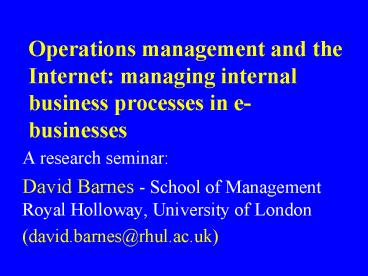Operations management and the Internet: managing internal business processes in ebusinesses
1 / 20
Title:
Operations management and the Internet: managing internal business processes in ebusinesses
Description:
Companies may chose to separate clicks from bricks processes in order to: ... Avoid culture clashes between bricks & clicks workers ... –
Number of Views:155
Avg rating:3.0/5.0
Title: Operations management and the Internet: managing internal business processes in ebusinesses
1
Operations management and the Internet managing
internal business processes in e-businesses
- A research seminar
- David Barnes - School of Management Royal
Holloway, University of London - (david.barnes_at_rhul.ac.uk)
2
The research
- A three year project investigating the effect of
e-commerce on the management of core business
processes - Funded by the OUBS and CIMA
- The researchers
- David Barnes - Royal Holloway
- Matthew Hinton - Open University
- Suzanne Mieczkowska - Open University
3
What is e-commerce?
- The sharing of business information, maintaining
business relationships and conducting business
transactions by means of internet-based
technology - Includes three types of e-commerce
- Business to consumer e-commerce (B2C)
- Business to business e-commerce (B2B)
- Internal (intra-organisational) e-commerce
4
Operations management is the management of
business processes
- A process is a system transforming input into
output, which uses resources, and which is
subject to controls - Business processes can be classified as
materials, or customer, or information
operations, but are likely to be a mixture of
more than one of these
5
The Internet changes everything?
- The Internet creates almost unlimited information
flows within and between organisations and their
supply chain partners. - An explosion in connectivity and .. the open and
almost cost-free exchange of rich
informationeveryone can communicate richly with
everyone else
6
What does this mean for the management of
operations?
- The research aims to investigate the impact of
e-commerce on the management of internal business
processes. - This is a neglected area of study most attention
on technology, web design, dotcom booms and busts
etc
7
Research Aims
- Identify and describe the business processes used
for order fulfilment and delivery in e-commerce - Identify common patterns in those processes
- Identify what factors may affect those processes
- Develop testable propositions for future research
- Investigate how business process performance is
measured in e-commerce (funded by CIMA)
8
A framework for investigating e-commerce
business process
BUSINESS PROCESS INTEGRATION INTERNAL Between
clicks bricks processes EXTERNAL Outsourcing
of clicks processes Between outsourced clicks
bricks processes
INFORMATION SYSTEMS INTEGRATION INTERNAL
Across functions Between clicks bricks
processes EXTERNAL With customers With
suppliers
OPERATING CONTEXT CUSTOMERS B2B or B2C
E-COMMERCE MODEL Clicks mortar dotcom
start-up ORGANISATIONAL TYPE MNE, SME, for
profits, not-for profits
9
Empirical Research
- Investigates how organisations are adapting their
operations for e-commerce - Focuses on the use of Internet-based ICTs in
business operations - Uses a case study methodology
- Data collection via semi-structured interviews
with company managers - Uses the framework to guide data collection
10
The 12 case companies
11
The case companies (1)
- Multi-insure UK subsidiary of a large US
insurance broker - Rebankco The central mortgage office of a large
retail bank - UK Insure a multinational insurance broker
- Creditinsure an export credit insurer
- E-insure A Creditinsure spin-off, offering
credit and risk management to online trading
companies - Shareco a London SME share trader
12
The case companies (2)
- ARB a major steel producer
- Pharmco a small therapeutic pharmaceuticals
manufacturer - Equipco an industrial equipment manufacturer
- E-accounting an on-line finance and accounting
consultancy for SMEs. - Clothingco an online specialist clothing
retailer - Legalco an on-line legal services provider
13
Findings - 1
- Motives for e-commerce are confused
contradictory. - They can be
- Technology driven (the fear of being left behind
experiential learning seek technological
leadership) and/or - Marketing driven (target niches raise exit
barriers differentiation through on-line
service reach new customers cross selling)
and/or - Operationally driven (reduce costs improve
efficiency improve communications)
14
Findings - 2
- Barriers to increased use of e-commerce are
- social (e.g. conservative organisational and
industry cultures) and - technological (e.g. lack of industry standards
and open systems) - financial (e.g. lack of, or competition for,
investment funds)
15
Findings - 3
- E-commerce tends to automate (rather than
re-design) existing business processes - This reinforces existing functionally-based
structures - There is no learning from BPR (whatever happened
to Obliterate dont automate?)
16
Findings - 4
- Increased integration between bricks and clicks
business processes is inhibited by technology
barriers. - Limited IS integration due to
- Internal legacy systems
- Poor recent technology choices
- Incompatible IS of customers/suppliers
- Lack of industry standards
17
Findings - 5
- Increased integration between bricks and clicks
business processes is inhibited by business
barriers - Companies may chose to separate clicks from
bricks processes in order to - Limit risks to existing business relationships
with customers and suppliers - Avoid culture clashes between bricks clicks
workers - Penetrate new market segments through e-commerce
18
Findings - 6
- The adoption of e-commerce challenges existing
supply network relationships - Disintermediation was predicted but this risks
relationships with existing intermediaries - Other possibilities
- Use e-commerce to support existing intermediaries
- Collaborate with partners (e.g. shared platform)
- Collaborate with competitors (e.g. joint
ventures, using their platform) - New intermediary businesses (reintermediation)
19
Findings - 7
- Performance measurement in e-commerce is poor
- Little evaluation of the impact of e-commerce
investments (including little or no
post-investment appraisal) - No agreement about performance measurement in
e-business (with few, and ad hoc performance
measures for e-business processes)
20
Future Research Plans
- Develop testable propositions from this research
and test in a large sample via a questionnaire - Develop a performance measurement system for
e-businesses - Develop a decision-making framework for
determining the right mix of bricks and clicks































